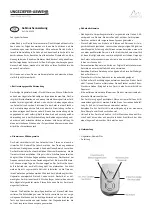
Design-In - Electrical Aspects
66/78
COMX Communication Modules | Design Guide
DOC100901DG18EN | Revision 18 | English | 2013-12 | Released | Public
© Hilscher, 2002-2013
3.5 SYNC Signals
COMX 100CA-RE, COMX 100CN-RE, COMX 51CA-RE and COMX 50CA-REFO provide SYNC
signals. The SYNC Signal has LVTTL level (3,3 V). A maximum load of 6 mA may not be ex-
ceeded. The SYNC Signals can only be used if this is supported by the respective firmware, see
below.
Possible Destruction of the Device due to high current!
Make sure that never two outputs drive against each other. Two outputs that drive
against each other cause a too high current and result in device damage. This situation
can happen for example, if the host system has an output signal connected to SYNC0
and a firmware is loaded that uses SYNC0 as output too.
It is also strongly recommended to keep the cable length for the SYNC signals below 50 mm and
to take EMC aspects into account.
In general, both SYNC signal lines can be used as input or output. The loaded firmware deter-
mines if the signal is an input signal or output signal. The following table shows the meaning of the
SYNC signals for the real-time Ethernet protocols currently offering SYNC signal support.
Protocol
Signal IO_SYNC0
Input/Output
Signal IO_SYNC1
Input/Output
From Firm-
ware Version
Remarks
EtherCAT Slave
SYNC 0
Output
SYNC 1
Output
- Configurable
PROFINET IO
Device
Bus cycle start (PROFINET IRT)
Output
- 3.4.x.x
-
sercos III Master
External trigger to start bus cycle
Input
Rising edge
- 2.0.8.0
-
sercos III Slave
CON_CLK
Output
DIV_CLK
Output
3.0.10.0
Configurable
Table 41: Meaning of the SYNC Signals for each Protocol













































